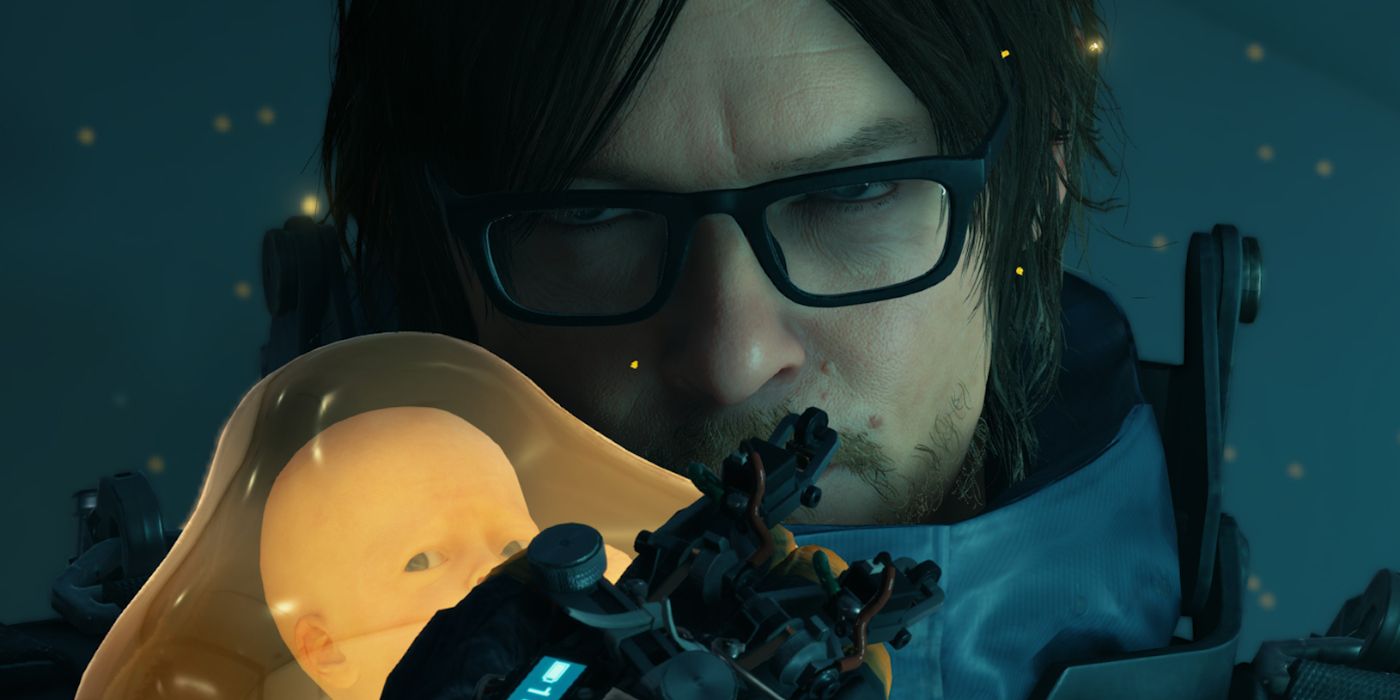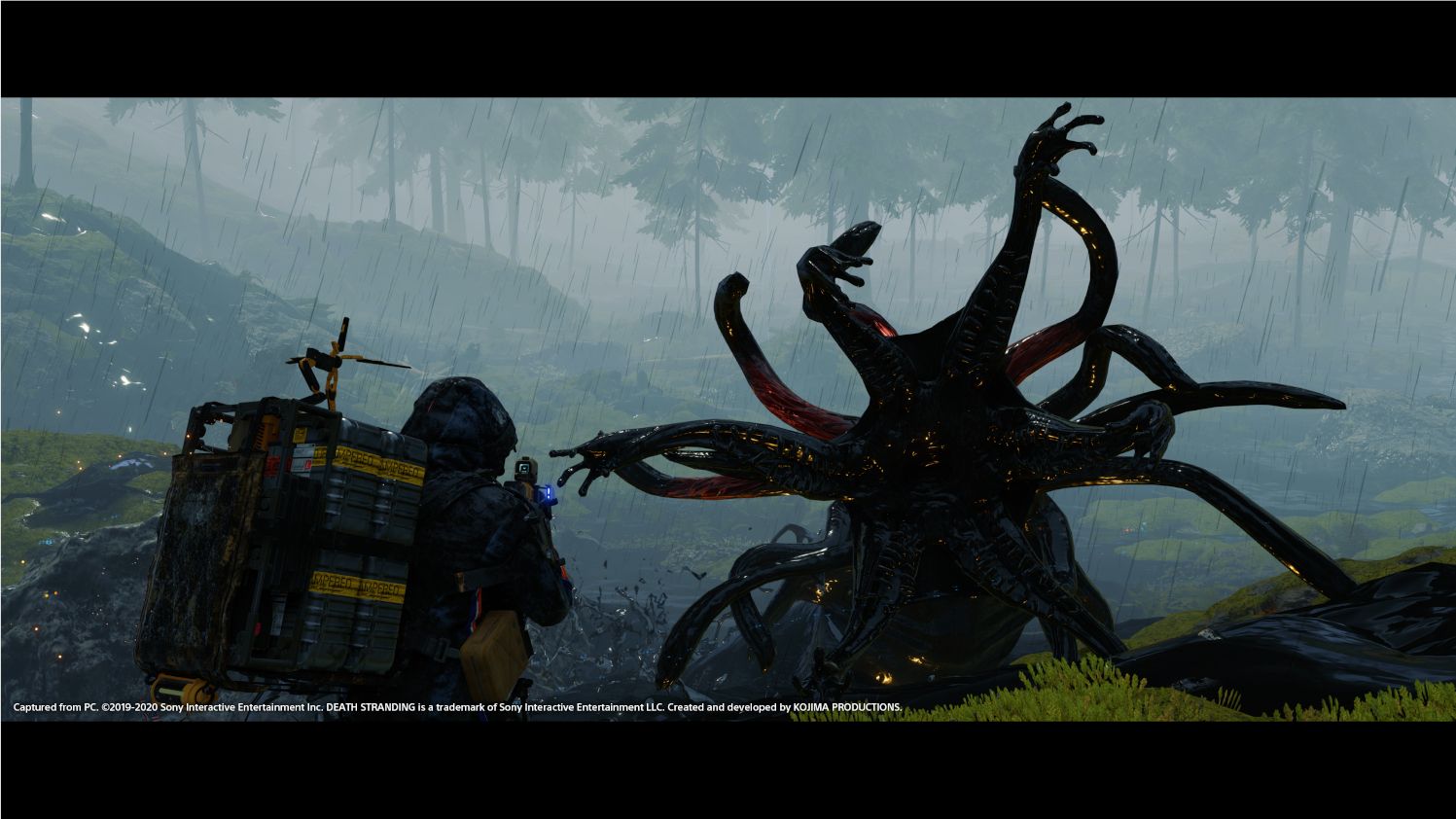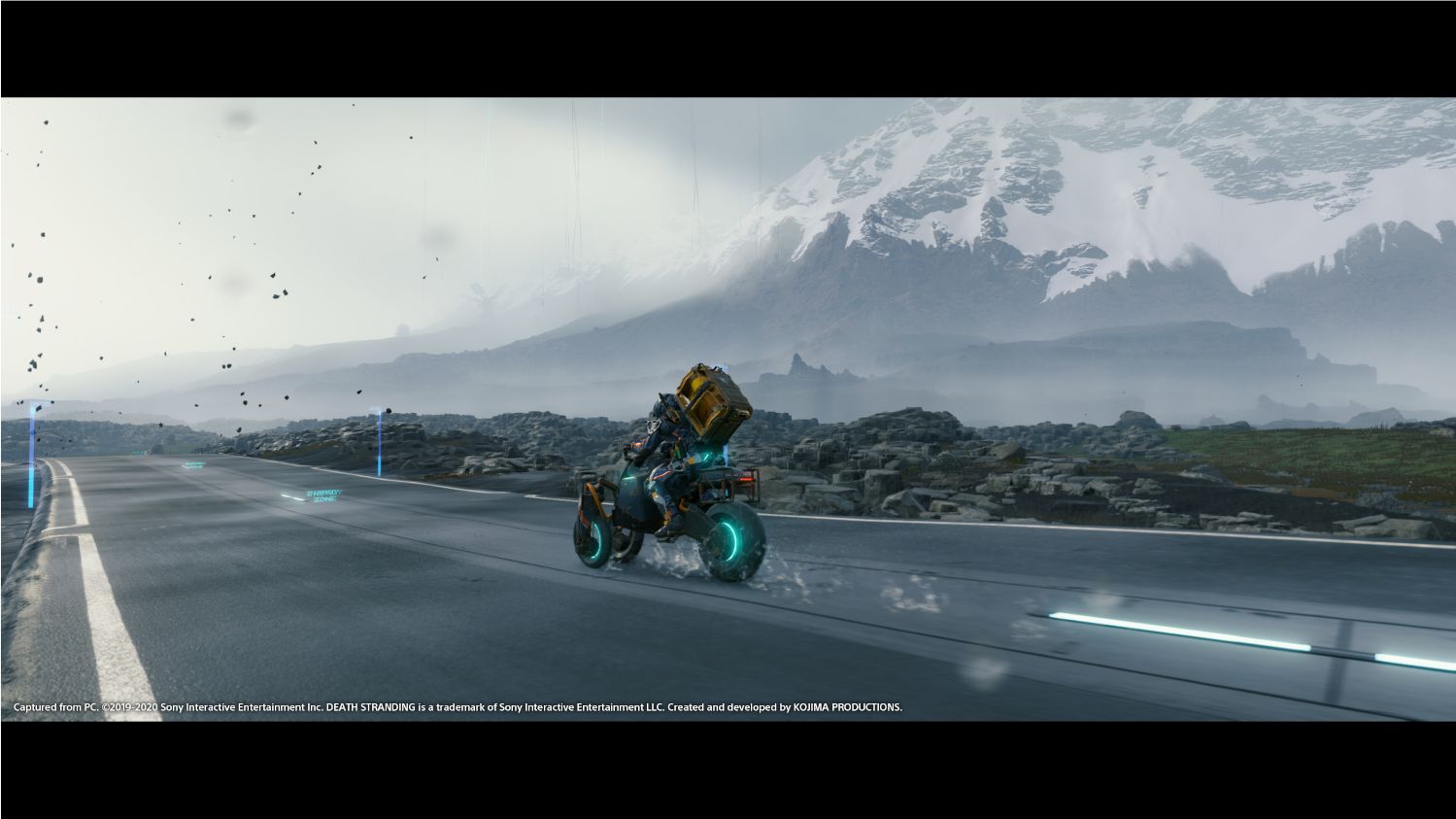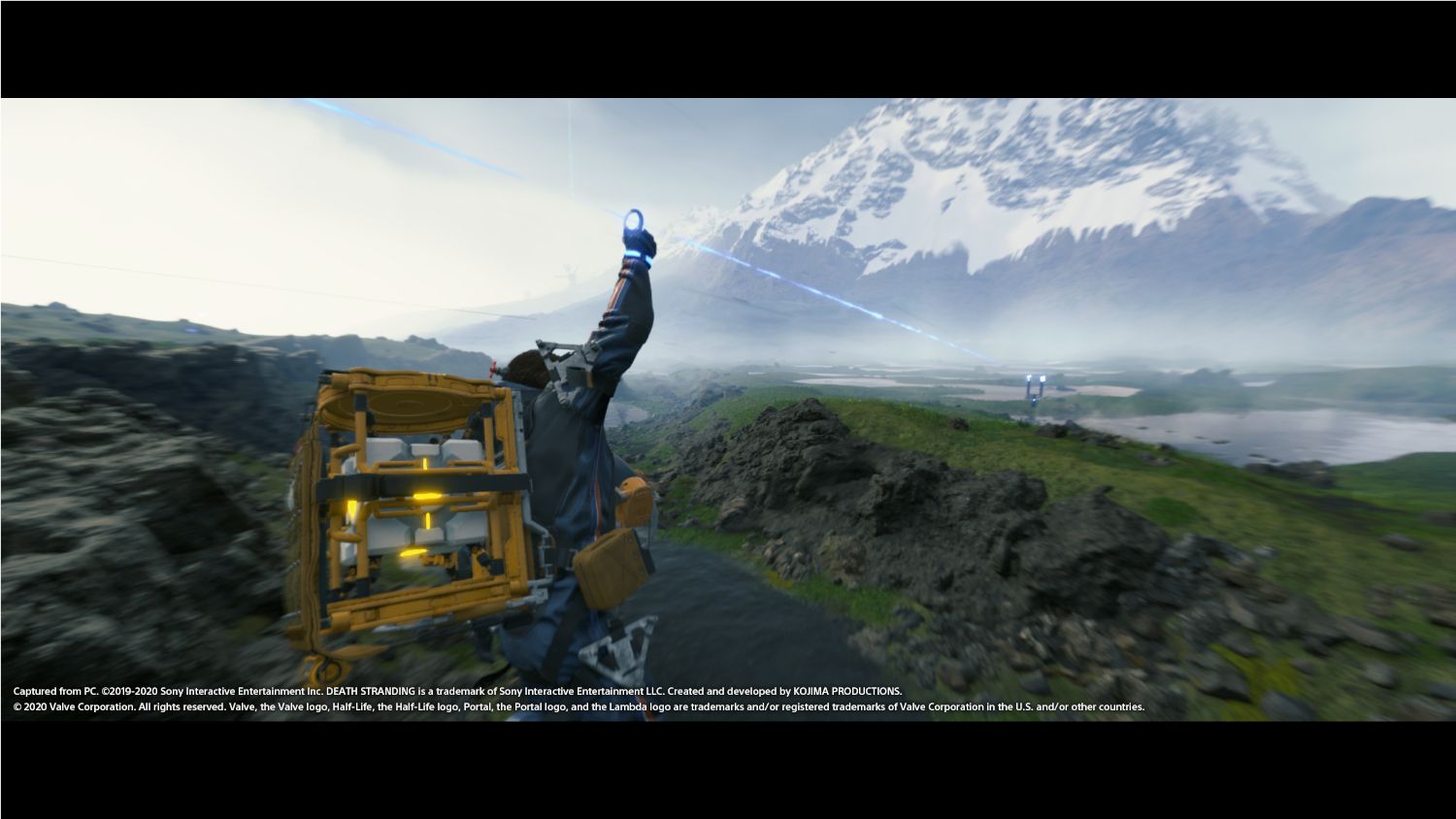Amazon Prime’s Patriot spoke often about an invented industrial philosophy: The Structural Dynamics of Flow. To quote the fictitious piping company McMillan’s CEO: “Essentially, we exist because of the tremendous difficulty inherent in simply transporting any entity from A to B.” Death Stranding explores the potential depth of this tension, exposing and exploring its essence and turning transport into a primary gameplay experience.
Norman Reedus is Sam Porter Bridges, a name to be repeated over and over in numerous configurations throughout the game. His surname doubles as the name of his employer, a delivery and courier service striving to re-knit a frayed post-apocalyptic country. Following a cataclysmic event known as the Death Stranding, the discovery of an afterlife realm known as The Beach and its perpendicular clash with living reality musters ghost-like dangers (Beached Things, or BTs) and anomalous terraforming of the planet, sending survivors off to their bunkers as preppers.
The PC version of Death Stranding played at time of review is clearly impressive, though individual specs may be a critical factor. On a powerful rig, it's possible to take in all the sights with what appears to be an infinite draw distance. In another nod to Dark Souls, this is a game where those mountains in the skybox aren’t window dressing and can eventually be scaled, and the PC version appears noticeably less choked with distant fog than the PS4. Textures never seem to waver or degrade, and the entire world seems crisper and more vibrant than before. It’s not a complete night-and-day difference - in its original console appearance, the game was already a visual marvel to start - but a good PC will deliver a quicker and sharper experience than that of the PS4. The soundtrack is identical, brilliantly composed and mood-altering, but there are now some nifty Half-Life/Portal easter eggs and tools to enjoy, appearing in the form of occasional bonus missions that are always worth the time to seek out.
In terms of narrative, Death Stranding features an enormous amount of backstory and ephemera all well beyond the scope of any short review. There are Bridge Babies, or BBs, a kind of ghostly alert system in the form of a permanent infant in a mechanical suit-mounted womb which some porters like Sam wield against the new world’s horrors. There are MULEs, renegade factions of porters who stake out hunks of geography and rob hapless couriers of their cargo. Sam himself is a “repatriate,” someone who can enter his Beach (in other words: die), but always find his way back to the living, a helpful trait for his career. In addition to his trusty BB, Sam can attach cargo of varying weight to different parts of his body, which factors into his gait, movement speed, and stability, but it can be damaged by everything from Timefall (a kind of age-inducing acid rain) to just tumbling down a steep mountainside. Before too long, Sam gains access to vehicles, including motorcycle-like ATVs and even shipping trucks, but this doesn’t immediately put the game on easy mode, as vehicles need to be charged up and can be quickly damaged, let alone prevent successful navigation through rocky ravines.
Death Stranding is also a deep game of menus. Taking on a mission typically involves the following routine: find an access point in a bunker, open a menu to choose a mission and confirm where it will lead, fabricate any equipment or conveyance required using on-site resources, decide where to place the cargo. Confirm, confirm, confirm. Get kicked out of the menu to start the mission, then realize that Sam is overburdened and needs to store some gear before departure. Reopen the menus, stash Sam's gear in a private locker. Check the map, zoom to weather, realize that Sam will be heading through heavy Timefall. Better to opt for a truck with a closed roof to store packages, then. Back to menus, fabricate a truck, place everything in the truck, get in the truck, drive off the ramp.
At least it's helpful that input hotswapping is activated by default, similar to how The Witcher 3 works on PC. Basically, when moving the mouse or typing a key on the keyboard, button prompts immediately switch over from controller, and vice versa. Seems like a small inclusion, but it's surprising how many games - ports and otherwise - release with built-in hotswapping restrictions and, for such a menus-focused release like Death Stranding, to include this at launch may be a boon to certain players in how they manage these intricacies.
Of course, the whole process gets easier as players learn the lay of the land and manifest their preferred style of play. There are a series of lethal and non-lethal weapons (the dead summon anomalies, so even a single murder literally threatens everyone in the world), but it's also possible to path to objectives while steering clear of most threats. In the game’s clumsier early hours, it’s impossible to put any of this together coherently, as many missions seek to place Sam in direct proximity to BTs and MULEs to introduce players to these encounters. Truly, those earliest moments of the game are somehow the most confusing and least interesting. To be fair, though, Death Stranding has a lot to both show and tell, but it can still feel a little too on-rails for a little too long.
After Death Stranding opens up, however, the unique online systems slink into view. While there’s no direct co-op play, a persistent online community somewhat akin to that of the Soulsborne series emerges, as players manipulate and create structures to help themselves and each other. Things like bridges, roads, storage lockers, generators, even territory-spanning ziplines eventually appear, transforming the lethal landscape into a buzzing network of efficient transport. As players use and construct these assets, players can give each other “Likes,” improving standing and granting stamina boosts, all of which is handled in-world in concrete, lore-rich fashion. It’s the game’s most fascinating quirk, and it’s weirdly inspiring to find that an old generator constructed in the first 20 hours of play has now been upgraded by other people playing the game, collecting thousands of likes throughout the days. Players can even help each other finish deliveries and return and share lost gear, tempering Sam’s hostile world with a sense of warm allyship.
That being said, building large structures can be tedious. Materials for upgrades and construction are heavy, so it’s usually not a matter of stumbling to a spot and thoughtlessly constructing a chunk of highway. By this point in the game, Sam is staring at the map and putting in some careful engineering consideration, forecasting what would most benefit him and his invisible online friends in the long term. That means jumping back into a myriad of menus, scraping materials from different waystations, driving them across miles of dangerous land. This process can be challenging, even plodding, but is no less satisfying to complete, and devoting hours to it can happily eat up game-time, in a surprising parallel to completing a big resource-heavy project in Animal Crossing: New Horizons.
Players familiar with the PlayStation 4 version won't see much of a difference in performance or load times - again, granting that they have a suitable PC to run the game. Initial loads from the startup screen do take a minute or two, but no other significant loading times are apparent, even those between discrete chapters. For such a spacious experience, Sam can run from swamps to snow with no visible transitions or hiccups at all, securing the notion that Death Stranding's PC port arrives perfectly intact and consistent with what console players might expect.
Through its many turns, Death Stranding is a frustrating, confounding game. There are distinct points in the narrative where it will shed a percentage of its players, but other points that will tightly secure the ones who remained for the long haul, pun intended. It’s a concentration of Kojima’s strengths and faults as a somewhat deified auteur, a visionary whose work has often steered the medium through its checkpoints while serving his indulgences to a fault. The narrative can be as tedious as some of the toughest package deliveries—for one thing, more of the story is told in monologues and emails than actual conversations, partly due to the quarantined characters, granting the story an unnaturally stilted pace—but even those most reticent to Kojima’s storytelling will find memorable qualities and encounters. Death Stranding is a game meant to be experienced by all, even those who won’t complete it, and a good PC build makes this the best version to determine if Sam is the right porter for the job.
Death Stranding releases on Steam and the Epic Games Store for PC on July 14. A digital copy was provided to Screen Rant for purposes of review.




